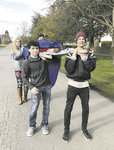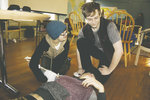On an otherwise ordinary Wednesday morning, students of Jefferson Community School (JCS) put into practice the emergency preparedness skills they’d practiced for more than a month.
While the …
This item is available in full to subscribers.
We have recently launched a new and improved website. To continue reading, you will need to either log into your subscriber account, or purchase a new subscription.
If you had an active account on our previous website, then you have an account here. Simply reset your password to regain access to your account.
If you did not have an account on our previous website, but are a current print subscriber, click here to set up your website account.
Otherwise, click here to view your options for subscribing.
* Having trouble? Call our circulation department at 360-385-2900, or email our support.
Please log in to continue |
|


On an otherwise ordinary Wednesday morning, students of Jefferson Community School (JCS) put into practice the emergency preparedness skills they’d practiced for more than a month.
While the rest of downtown Port Townsend was experiencing a tranquil, sunny day March 22, the teens at JCS responded to a simulated earthquake by ducking for cover under their tables.
After the adults conducting the exercise called an “all clear,” the class found itself faced with the task of mending its “injured” members, with student Henry Stier pretending to suffer from a broken arm and spinal injuries, while Travis McConaghy affected a limp to act out having a broken leg.
“They’re going to make a lot of mistakes, “said Keppie Keplinger, public information officer for the Port Townsend Police Department and the Jefferson County Department of Emergency Management. “That’s why they’re doing this, to see how well they can follow directions in crisis.”
Max Stewart emerged early as an assertive student leader, calling for assistance from her classmates in assembling makeshift stretchers and splints for Stier and McConaghy even as a simulated aftershock interrupted their attempts at treatment by forcing them briefly back under their tables.
From there, the students carried their injured comrades, as well as heavy “grab and go” kit bags stocked with emergency supplies, up the hill to residential homes that had been designated as temporary shelters, not just for that day’s exercise, but in the event of an actual emergency.
REAL LIFE
Judy Drechsler is a neighborhood preparedness leader for an area that encompasses her home on Franklin Street, which sits much higher than 50 feet above sea level – the elevation people living and working downtown are advised to reach in the event of a tsunami. Michele Gransgaard and Fred and Marilyn Miller are members of the same neighborhood group, and were also there to welcome the students.
Port Hadlock resident Mark Bauserman, whose son attends Jefferson Community School, had contacted the Department of Emergency Management late last year and worked with Keplinger to set up a basic preparedness class, after learning that the school lies within Port Townsend’s tsunami inundation zone.
After witnessing the pilot project in action March 22, as more than a dozen students evacuated their school building and carried out instructions they had been learning since Feb. 8, Bauserman said he thought that the students had done “fairly well” in hitting their marks.
“You took it pretty seriously,” Bauserman told the students during a day-after review of the drill. “Not completely seriously, but in a real emergency, there would have been a bit more energy, I think.”
SKILLS FOR EVERYDAY USE
While both “victims” were worried about being dropped by the stretcher-bearers, they and their classmates echoed the optimistic outlook of Bauserman and teacher David Miller, who praised them for doing “really awesome.”
“I’m just glad that we did it and no one died,” Stewart said, even as she voiced the group’s shared complaints about carrying seabags laden with supplies, plus two people who couldn’t move themselves.
“I was surprised by how effective we were,” said classmate Story Walsh, who shared Stewart’s confidence that they could pass on what they’d learned to those who hadn’t received the same training.
“I can make a stretcher now with two sticks and some duct tape,” Stewart said. “I’ve picked up skills that will help me in everyday life, not just emergency situations.”
“As a school, we’ve taken measures to prepare ourselves for a disaster,” said Stier, who’s been excited to learn first aid and CPR. “These are still the early stages, but I’d say it’s been successful so far. We’re definitely doing more than most other schools. I’m looking forward to the lessons being even more dramatic and intense in the future.”
Bauserman, Keplinger and Stryker Gooch, an experienced hiker and mountaineer, made it a goal to furnish the students with survivals skills that can be transferred beyond the classroom, and even to other countries.
HAM RADIO OPERATORS
The March 22 “bug out” drill was the seventh in a series of 12 classes that have taught students about post-disaster communication options, including the school’s ham radio. Keplinger reported that at least two students are licensed ham operators.
The students also have toured the department’s Emergency Operations Center (EOC), where department director Lynn Sterbenz explained how the agency’s incident management team functions when the EOC is activated in response to a disaster.
While there, the students had the opportunity to look into the dispatch center and observe how the operators answer 911 calls. Marlo Erwick, a JeffCom 911 operator, answered a simulated 911 call from one of the students.
Other hands-on lessons for the students of the course curriculum include a tour of East Jefferson Fire Rescue’s Port Townsend station, complete with training on how to use a fire extinguisher.
“Starting this pilot project has been challenging for all of us, students and instructors alike,” Keplinger said. “Through it, we’ve learned the best ways to provide experiences to the students, which helps to create the muscle memory moments that will allow them to stay safe and help others, should the need arise. We are fine-tuning our teaching moments, with the goal of making this program adaptable in other school settings.”